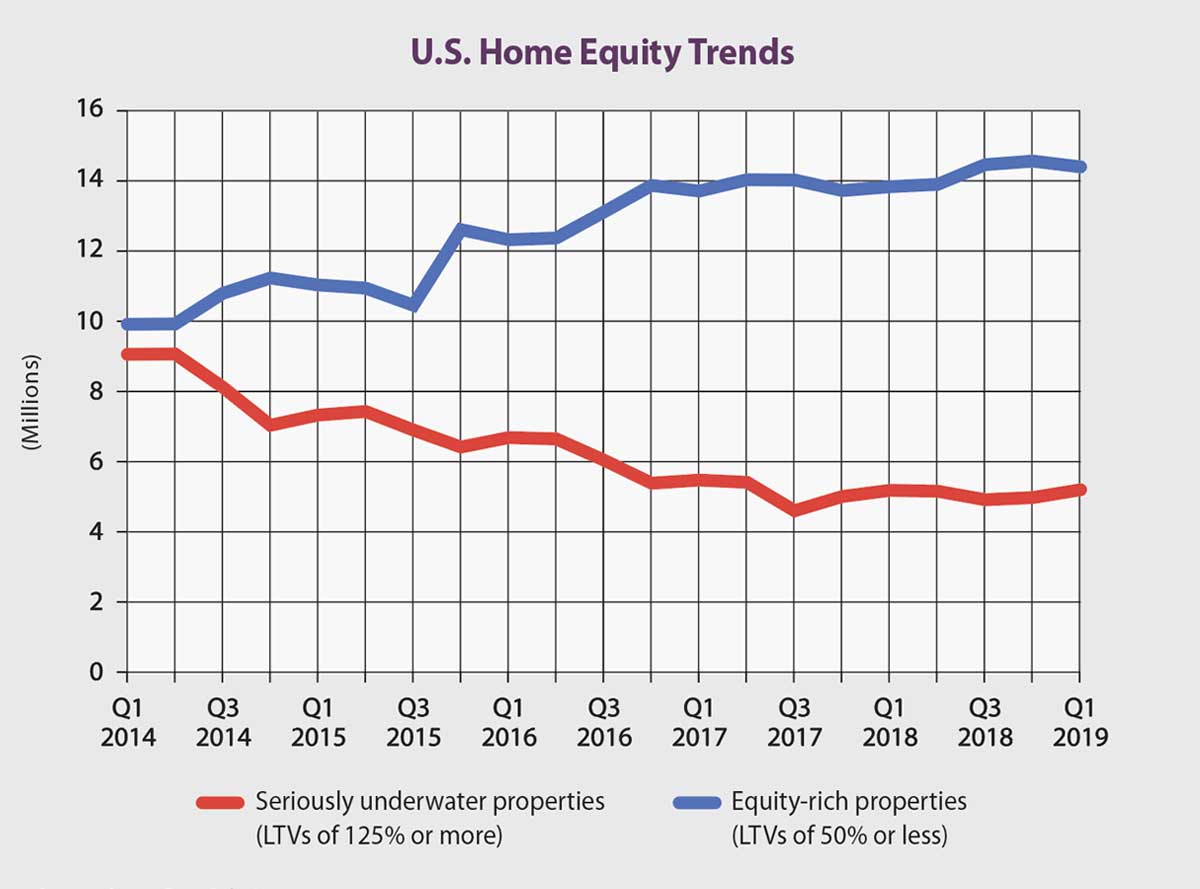Underwater mortgages and what they signal have long been a concern for the real estate financing industry. Mortgage originators may wonder if home prices are slipping, more risky mortgages are being issued or whether refinance candidates are banking on price increases that may not come. Although the causes of underwater mortgages may vary from property to property, their overall trends bear watching.
At the end of first-quarter 2019, there were more than 5.2 million residential properties in the U.S. with seriously underwater mortgages, according to Attom Data Solutions’ U.S. Home Equity and Underwater Report. We define a home as “seriously underwater” if the combined balance of loans secured by the property is at least 25% higher than the property’s estimated market value (in other words, a loan-to-value ratio of 125% or higher).
These 5.2 million homes represent 9.1% of all U.S. properties with a mortgage. Although this share is significantly lower than the post-recession peaks of 28%, it is an increase from the 8.8% of homes that were seriously underwater in fourth-quarter 2018.
Last year, home-price appreciation moved at a slower rate than in previous years, which means that fewer homeowners were able to make the move from being underwater to having equity. Despite this, 25.1% of properties in the U.S. were deemed “equity rich” by Attom’s report, which means the homeowner has at least 50% equity in the property.
Although this is down from a high of 26.4% seen in third-quarter 2017, a robust portion of property owners remain equity rich, especially when compared with shares of less than 20% seen in the years immediately after the recession. Equity-rich properties are down slightly year over year from the 25.3% seen in first-quarter 2018.
As is often the case with real estate, however, these numbers can highlight the stark differences in property values and mortgages from city to city and state to state. Cities in Louisiana, Ohio and Pennsylvania, for example, are facing serious issues with underwater mortgages.
In fact, out of the 99 metropolitan statistical areas analyzed in the report, the cities with the highest percentages of seriously underwater properties were Baton Rouge, Louisiana (21.3%); Scranton, Pennsylvania (20%); Youngstown, Ohio (19.2%); Toledo, Ohio (19.2%); and New Orleans (17.8%). With the exception of Louisiana, however, the negative-equity shares in these cities did not directly correlate with broader state numbers. The states with the highest shares of seriously underwater properties were Louisiana (20.7%), Mississippi (17.1%), Arkansas (16.3%), West Virginia (16.2%) and Illinois (16.2%).
On the other hand, cities in California, Washington and Hawaii are faring well and have some of the highest shares of equity-rich properties. Among the same 99 metropolitan statistical areas analyzed in the report, the markets that had the highest shares of equity-rich properties included San Jose, California (68.3%); San Francisco (58.4%); Los Angeles (48.1%); Honolulu (38.6%); and Seattle (37.3%). The results are similar when analyzing the states with the highest shares of equity-rich properties: California (43%), Hawaii (38.1%), New York (34.2%), Washington (33.2%) and Vermont (32.8%) make up the top five.
Unsurprisingly, these numbers reflect other issues in the U.S. real estate market. States with high amounts of home equity are the same states that boast some of the highest-priced real estate in the country. And states that have issues with underwater mortgages are the same states struggling with low home values and foreclosures. For now, there seems to be some balance in the national housing market, but keeping an eye on these telling numbers will help mortgage originators better anticipate which way the market will turn.
Author
-

Todd Teta is chief product and technology officer at Attom Data Solutions, where he leads the company’s technology and product teams. Prior to joining Attom Data Solutions, Teta led the product-development and technology organization at Meyers Research. Teta also previously co-founded several startups, including VisionCore, a company serving the mortgage and real estate data and analytics markets that was later sold to CoreLogic. He is a graduate of the University of Southern California, where he earned a degree in computer engineering and computer science. Learn more about Attom Data Solutions at attomdata.com.





